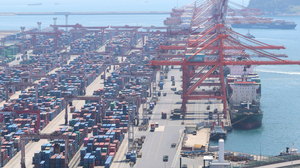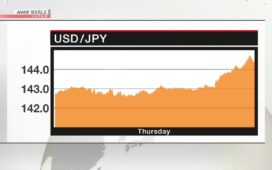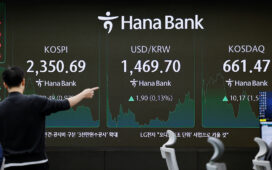US Treasury’s upcoming currency report could provide hints on forex approach

The chronic devaluation of the South Korean won is a subject of interest for both the Korean and US administrations — significant enough to be included in their high-stake trade negotiation.
While Seoul and Washington have agreed to craft a trade package to eliminate US tariffs on Korean exports, the discussion will cover four main areas: tariffs and non-tariff barriers, economic security, investment cooperation and exchange rate policy.
“The two countries’ finance ministries will hold separate consultations on the forex policy issue, with working-level talks expected to start soon,” Finance Minister Choi Sang-mok told the press, shortly after Korean officials wrapped up trade consultations with their US counterparts in Washington last week.
US President Donald Trump has repeatedly expressed his desire for a weaker dollar as part of his broader effort to reindustrialize the nation and fulfill his “Make America Great Again” agenda.
In his view, the dollar’s role as the world’s dominant reserve currency drives up its value, making US exports less competitive abroad and hurting domestic manufacturers. Thus, a weaker dollar is necessary to narrow both trade and fiscal deficits.
It seems that he has gotten his wish. The dollar index, a key measure of the currency’s strength, weakened by more than 9 percent so far this year, influenced by the uncertainty about US policymaking.
By imposing steep tariffs, the US aims to not only pressure other countries to address the country’s trade deficit, but also induce further depreciation of the dollar.
Limited room for intervention
Prior to the negotiations, the US Treasury Department’s upcoming report on Macroeconomic and Foreign Exchange Policies of Major Trading Partners of the United States — or the “currency report” for short — is expected to provide a glimpse into the US administration’s stance towards exchange rates.
In the November edition of the biannual report, the US reinstated Korea on its forex monitoring watchlist as it met two of its three conditions: the size of Korea’s trade surplus with the US and its account surplus.
But when it comes to the third condition, persistent net purchases of foreign currency, Korea has its own view.
“Korea can defend itself as its authorities are not making interventions in the market to purposely make the won weaker,” said Jung Kyu-chul, director of the Office of Macroeconomic Analysis and Forecasting at the Korea Development Institute, adding the country could take the higher ground in the discussion.
Rather, the authorities are intervening to make the won stronger. Last year, the local authorities net sold $11.17 billion on the market to stabilize the currency exchange rate, meaning it encouraged the appreciation of the won.
While the Plaza Accord in 1985 aimed to devalue the US dollar against the Japanese yen and other currencies to reduce the US trade deficit, experts agreed that another such deal would be meaningless in the current circumstances.
“The forex market is not bilateral, but multilateral. It would be nearly impossible to make the won-dollar rate move in a certain direction,” an official from the local forex authorities said.
Yet the role of the National Pension Service on the forex market could be a touchy subject in currency policy discussions with the US.
The NPS is a major buyer of dollars on the forex market. Of its global equity holdings worth 431 trillion won ($300 billion), 66.7 percent is based in North American markets as of December.
The pension fund operator has to buy dollars when making foreign equity investments, which adds pressure on the buying side of the dollar on the forex market, consequently strengthening the dollar and weakening the Korean won.
In the currency report released in June 2022, the US Treasury mentions Korea’s “sizable equity outflows” as one of the factors behind “persistent won weakness,” explicitly mentioning the increase in total foreign asset holdings by the NPS.
Weak dollar, weaker Korean won
While Trump pushes for a weaker dollar, the depreciation of the Korean won has been outpacing that of the greenback.
On Wednesday, the Korean won wrapped up daytime trading at 1,421 won to the dollar. It has been unable to strengthen to the 1,300 won range since October last year.
The Korean won’s devaluation against the greenback is likely to continue for a while as long as the interest rate gap between the two countries remains at the current level. The Korea-US rate differential stands at up to 1.75 percentage points for the time being.
Though the won could strengthen if the Bank of Korea raises the policy rate, the possibility remains low with the ailing local economy, Jung from the KDI said.
“The base rate reflects the strength of the local economy. The won is weak because the Korean economy is weak. It will only strengthen when the Korean economy improves.”





